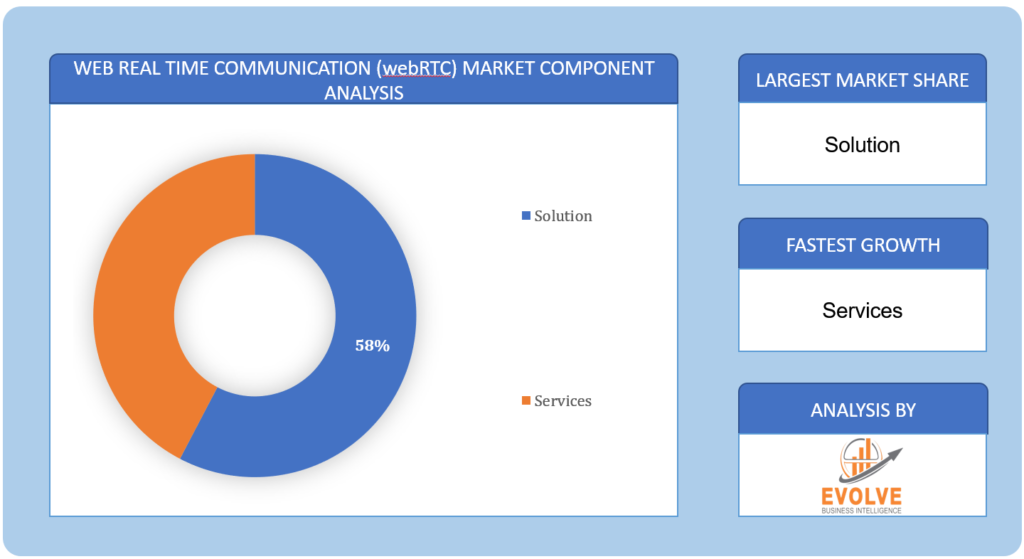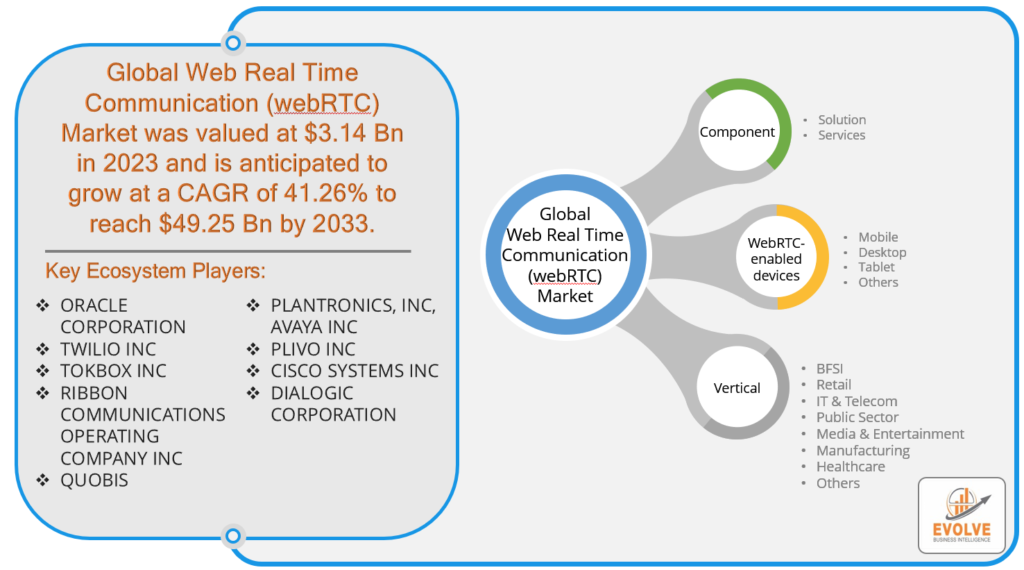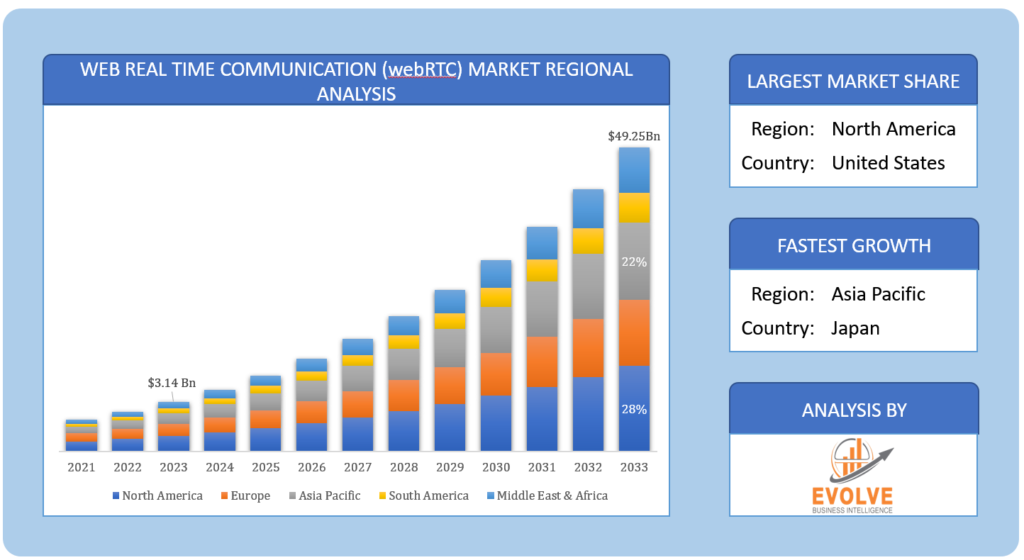Web Real-Time Communication (webRTC) Market Overview
The Web Real-Time Communication (webRTC) Market Size is expected to reach USD 49.25 Billion by 2033. The Web Real-Time Communication (webRTC) industry size accounted for USD 3.14 Billion in 2023 and is expected to expand at a CAGR of 41.26% from 2023 to 2033. Web Real-Time Communication (WebRTC) is an open-source technology and collection of protocols that enables real-time communication, such as audio and video conferencing, directly in web browsers and mobile applications without the need for additional plugins or third-party software. It allows users to establish peer-to-peer connections for seamless, low-latency communication, making it ideal for applications like video chats, online gaming, and other interactive experiences. WebRTC leverages standard web technologies like JavaScript and HTML5 to provide a secure and efficient means of real-time communication over the Internet.
Global Web Real-Time Communication (webRTC) Market Synopsis
The Web Real-Time Communication (WebRTC) market witnessed a moderate impact from the COVID-19 pandemic. While the demand for real-time communication solutions, such as video conferencing and online collaboration tools, surged during the pandemic due to remote work and the need for virtual social interactions, WebRTC was already well-positioned to meet this demand. As a browser-based, plugin-free technology, it enabled businesses and individuals to quickly adopt and integrate real-time communication features into their applications and websites. This adaptability and ease of use made WebRTC a preferred choice for many seeking to connect in a socially distanced world, contributing to its continued growth during the pandemic and beyond.
Global Web Real-Time Communication (webRTC) Market Dynamics
The major factors that have impacted the growth of web real-time communication (webRTC) are as follows:
Drivers:
⮚ Enhanced Online Communication
The Web Real-Time Communication (WebRTC) market is the growing demand for enhanced online communication tools. WebRTC allows businesses to easily integrate real-time audio and video communication features into their websites and applications, facilitating seamless customer support, remote collaboration, and virtual events. This demand was further accelerated by the COVID-19 pandemic, as more people turned to online communication for work, education, and social interactions.
Restraint:
- Security Concerns
A significant restraint for the WebRTC market is the potential security vulnerabilities associated with real-time communication. While WebRTC is built with security in mind, it still relies on the internet, making it susceptible to cyber threats. Ensuring the privacy and security of sensitive data transmitted over WebRTC channels remains a challenge, especially for industries with stringent security requirements such as healthcare and finance.
Opportunity:
⮚ IoT Integration
An exciting opportunity for the WebRTC market is its integration with the Internet of Things (IoT). WebRTC can enhance IoT applications by enabling real-time communication between devices and users. For example, it can facilitate video calls between a user and a smart home security camera. This convergence of WebRTC and IoT opens up new possibilities for remote monitoring, control, and automation, offering innovative solutions for various industries, including healthcare, smart homes, and industrial applications.
Web Real-Time Communication (webRTC) Market Segment Overview
By Component
 Based on the Component, the market is segmented based on Solutions and services. The Solution segment was projected to hold the largest market share in the Web Real-Time Communication (WebRTC) market due to the high demand for integrated real-time communication solutions in various applications, such as video conferencing, customer support, and online collaboration.
Based on the Component, the market is segmented based on Solutions and services. The Solution segment was projected to hold the largest market share in the Web Real-Time Communication (WebRTC) market due to the high demand for integrated real-time communication solutions in various applications, such as video conferencing, customer support, and online collaboration.
By WebRTC-enabled devices
Based on the WebRTC-enabled devices, the market has been divided into Mobile, Desktop, Tablet, and Others. The Mobile segment is expected to hold the largest market share in the Web Real-Time Communication (WebRTC) market due to the widespread adoption of mobile devices and the increasing demand for real-time communication on smartphones and tablets.
By Vertical
Based on Vertical, the market has been divided into BFSI, Retail, IT & Telecom, Public Sector, Media & Entertainment, Manufacturing, Healthcare, and Others. The BFSI segment is expected to hold the largest market share in the Web Real-Time Communication (WebRTC) market due to its growing demand for secure and efficient real-time communication solutions.
Global Web Real-Time Communication (webRTC) Market Regional Analysis
Based on region, the market has been divided into North America, Europe, Asia-Pacific, the Middle East & Africa, and Latin America. The area of North America is anticipated to dominate the market for the usage of Web Real-Time Communication (webRTC), followed by those in Asia-Pacific and Europe.
 North America Market
North America Market
North America continues to assert its dominance in the Web Real-Time Communication (WebRTC) market due to a combination of factors. The region’s well-established IT infrastructure, strong presence of major WebRTC solution providers, and a thriving tech ecosystem have created a conducive environment for WebRTC adoption. Furthermore, the North American market benefits from the increasing demand for real-time communication solutions across various industries, including healthcare, education, and business, which has propelled its growth. The region’s commitment to data privacy and security also aligns with the stringent requirements of these sectors, further bolstering its position as a key player in the global WebRTC landscape.
Asia Pacific Market
The Asia-Pacific region has witnessed remarkable growth in the Web Real-Time Communication (WebRTC) market due to several compelling factors. With its burgeoning population and rapid digitalization, the region has become a hotspot for technology adoption. Increasing smartphone penetration and affordable internet connectivity have fueled the demand for real-time communication solutions across various sectors, such as e-commerce, telemedicine, and distance learning. Moreover, the Asia-Pacific region hosts a growing number of tech startups and enterprises, which are eager to leverage WebRTC to enhance customer engagement and communication. This, coupled with the rising need for cost-effective and scalable communication tools, has positioned the Asia-Pacific as a significant player in the global WebRTC market.
Competitive Landscape
The competitive landscape includes key players (tier 1, tier 2, and local) having a presence across the globe. Companies such as Tokbox Inc., Ribbon Communications Operating Company Inc., Quobis, and Plantronics, Inc. are some of the leading players in the global Web Real-Time Communication (webRTC) Industry. These players have adopted partnership, acquisition, expansion, and new product development, among others as their key strategies.
Key Market Players:
- ORACLE CORPORATION
- TWILIO INC
- TOKBOX INC
- RIBBON COMMUNICATIONS OPERATING COMPANY INC
- QUOBIS
- PLANTRONICS, INC
- AVAYA INC
- PLIVO INC
- CISCO SYSTEMS INC
- DIALOGIC CORPORATION
Key development:
In September 2019, Cisco Systems, Inc. revealed its plans to acquire Voicea, a company specializing in real-time solutions. This strategic acquisition was intended to bolster Cisco Systems Inc.’s Webex portfolio by integrating transcription services that combine automated speech recognition and artificial intelligence (AI).
Scope of the Report
Global Web Real-Time Communication (webRTC) Market, by Component
- Solution
- Services
Global Web Real-Time Communication (webRTC) Market, by WebRTC-enabled devices
- Mobile
- Desktop
- Tablet
- Others
Global Web Real-Time Communication (webRTC) Market, by Vertical
- BFSI
- Retail
- IT & Telecom
- Public Sector
- Media & Entertainment
- Manufacturing
- Healthcare
- Others
Global Web Real-Time Communication (webRTC) Market, by Region
- North America
- US
- Canada
- Mexico
- Europe
- UK
- Germany
- France
- Italy
- Spain
- Benelux
- Nordic
- Rest of Europe
- Asia Pacific
- China
- Japan
- South Korea
- Indonesia
- Austalia
- Malaysia
- India
- Rest of Asia Pacific
- South America
- Brazil
- Argentina
- Rest of South America
- Middle East & Africa
- Saudi Arabia
- UAE
- Egypt
- South Africa
- Rest of Middle East & Africa
| Parameters | Indicators |
|---|---|
| Market Size | 2033: $49.25 Billion |
| CAGR | 41.26% CAGR (2023-2033) |
| Base year | 2022 |
| Forecast Period | 2023-2033 |
| Historical Data | 2021 |
| Report Coverage | Revenue Forecast, Competitive Landscape, Growth Factors, and Trends |
| Key Segmentations | Component, WebRTC-enabled devices, Vertical |
| Geographies Covered | North America, Europe, Asia-Pacific, Latin America, Middle East, Africa |
| Key Vendors | ORACLE CORPORATION, TWILIO INC, TOKBOX INC, RIBBON COMMUNICATIONS OPERATING COMPANY INC, QUOBIS, PLANTRONICS, INC, AVAYA INC, PLIVO INC, CISCO SYSTEMS INC, DIALOGIC CORPORATION |
| Key Market Opportunities | • Enhance online learning experiences • The integration of WebRTC with IoT devices |
| Key Market Drivers | • Rising Demand for Real-Time Communication • Cost-Effective Communication Solutions |
REPORT CONTENT BRIEF:
- High-level analysis of the current and future Web Real-Time Communication (webRTC) Industry trends and opportunities
- Detailed analysis of current market drivers, restraining factors, and opportunities analysis in the future
- Historical market size for the year 2021, and forecast from 2023 to 2033
- Web Real-Time Communication (webRTC) market share analysis for each segment
- Competitor analysis with a comprehensive insight into its product segment, financial strength, and strategies adopted.
- Identifies key strategies adopted by the key players including new product development, mergers and acquisitions, joint ventures, collaborations, and partnerships.
- To identify and understand the various factors involved in the global Web Real-Time Communication (webRTC) market affected by the pandemic
- To provide year-on-year growth from 2022 to 2033
- To provide short-term, long-term, and overall CAGR comparison from 2022 to 2033.
- Provide Total Addressable Market (TAM) for the Global Web Real-Time Communication (webRTC) Market.








